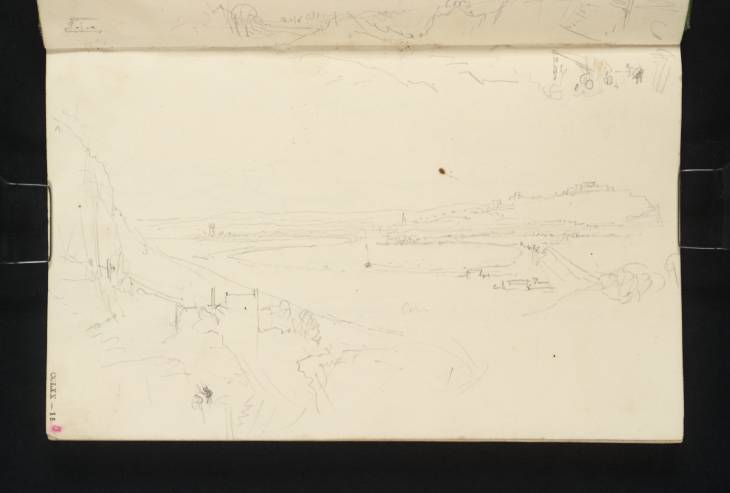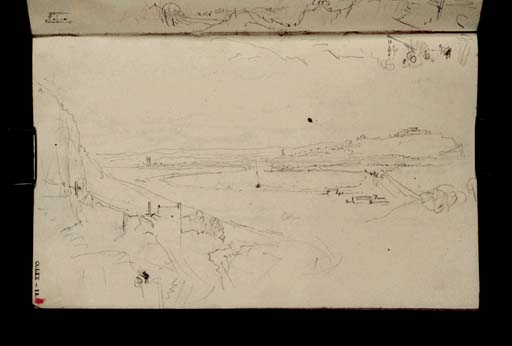Joseph Mallord William Turner Stirling 1831
Image 1 of 2
Joseph Mallord William Turner,
Stirling
1831
Joseph Mallord William Turner 1775–1851
Folio 13 Recto:
Stirling 1831
D26460
Turner Bequest CCLXX 13
Turner Bequest CCLXX 13
Pencil on white wove paper, 201 x 125 mm
Inscribed in pencil by Turner ‘corn’ centre
Inscribed in red ink by John Ruskin ‘13’ bottom left descending vertically
Stamped in black ‘CCLXX – 13’ bottom left descending vertically
Inscribed in pencil by Turner ‘corn’ centre
Inscribed in red ink by John Ruskin ‘13’ bottom left descending vertically
Stamped in black ‘CCLXX – 13’ bottom left descending vertically
Accepted by the nation as part of the Turner Bequest 1856
References
1909
A.J. Finberg, A Complete Inventory of the Drawings of the Turner Bequest, London 1909, vol.II, p.868, CCLXX 13, as “Sheriffmuir.”.
1936
Henry J. Crawford, Turner’s Sketches and Drawings of Stirling and Neighbourhood With Some Notes on the Artist’s Scottish Tours also A Note on John Ruskin and Stirling, Stirling 1936, pp.22–3, reproduced between pp.30–31.
1990
Dr David Wallace-Hadrill and Janet Carolan, ‘Turner’s Sketches North of Stirling’, Turner Studies: His Art and Epoch 1775 – 1851, Summer 1990, vol.10 no.1, p.17.
Turner visited Stirling on three occasions. The first was in 1801 as part of an extensive tour of Scotland where he made sketches of the town in the Scotch Lakes sketchbook (Tate D02927– D02984; D02992–D03276; D41240–D41249; D41411 complete; Turner Bequest LVI). He then returned in 1831 on his way from Edinburgh to the Clyde, and again in 1834 making sketches of the town in the Stirling and Edinburgh sketchbook (D26259–D26435; D41047–D41049 complete; Turner Bequest CCLXIX).
Turner certainly visited Stirling in 1831, making sketches in the Stirling and West sketchbook, as a sketch on folio 16 (D26466) is flanked by smaller sketches made later on the same tour and fitted into the limited available space. However, the possibility that he used the sketchbook again in 1834 is raised by a sketch on folio 15 verso (D26465) which includes the New Bridge, the foundation stone of which was laid on 8 September 1831 and which was completed in 1833.1 This raises the possibility that some of the sketches of Stirling in the Stirling and West book were made on the artist’s return to the town in 1834 when he was using the Stirling and Edinburgh sketchbook. However it seems unlikely that Turner would have brought an already rather full sketchbook with him to Scotland and used it alongside a half-empty sketchbook. Perhaps it is more likely that the Stirling and West sketches were all made in 1831, and that Turner simply added the New Bridge to folio 15 verso from memory on his return to London in October 1834.
Sketches of Stirling in this sketchbook are of the Holy Rude Church on folio 8 (D26450), the castle from the esplanade on folios 8 verso–9 verso (D26451–D26453), the castle from near the Old Bridge to the north (folios 10 verso, 11 verso, 15 and 15 verso; D26455, 26457, D26464, D26465), Cambuskenneth Abbey (folio 11 verso; D26457), the town from the north-east (folios 12 verso–14 verso; D26459–D26463), and the castle from Lady’s Rock (folios 16 and 16 verso; D26466, D26467).
After the 1831 tour Turner was commissioned to make a watercolour of Stirling circa 1834–5 (Glasgow Museums)2 to be engraved for Tales of a Grandfather, volume 23 of Sir Walter Scott’s Prose Works (1836). The illustrations for the Tales were apparently executed between 1834 and 1835,3 and the Stirling watercolour can be dated to 1834 or 1835 by the presence of the New Bridge.
The current sketch formed the basis of Turner’s watercolour, although two sketches on folio 12 verso (D26459) which were made from nearby, contributed to the composition and details. The view is from Abbey Craig, a hill about a mile-and-a-half to the north-east of Stirling Castle. The slopes of the hill are seen in the foreground with a loop of the River Forth in the middle distance and Castle Rock with Stirling Castle on it in the distance at the right of the sketch. Towards the left of the sketch in the middle distance is a tower which is probably the tower of Cambuskenneth Abbey. The tower just to the left of Castle Rock belongs to Holy Rude Parish Church (see folio 8; D26450). Neither the Old or New Bridges can be seen in the current sketch or on folio 12 verso.
The exact location from which this sketch was made can be identified by a separate sketch at the top right of this page (perhaps a continuation from the sketch on folio 12 verso). This depicts a crane which was incorporated in the watercolour. Further details in the watercolour such as blocks of stone and men working in groups make it clear that there is a quarry in the foreground. This is the Abbey Craig quarry which collected mill stone.4 The site of the quarry is marked on the present Ordnance Survey map to the east of Abbey Craig. There is also a sketch inscribed ‘Quarry’ on folio 14 (D26462), which is presumably the same one. Turner’s view is from above Wallace’s Pass to the west of Abbey Craig, which is shown at the bottom centre of the sketch and depicted with greater clarity in the watercolour. The building to the left of the pass was incorporated into the watercolour, where it appears to be some sort of works building. At the centre of the page is an inscription – ‘corn’ – which Wallace-Hadrill and Carolan have taken to designate Cornton, a community between Bridge of Allan and Stirling.5 However, Cornton is further to the west (right) than the scope of this sketch. An alternative meaning, suggested by Henry Crawford,6 is offered by the figure at the left of the watercolour, shown also in the sketch as a small black shape, who holds a scythe suggesting that the word must be corn. It is perhaps no coincidence that Turner should show both the production of corn and the stones with which to mill it in the same image.
Thomas Ardill
June 2010
‘Stirling Causeway Head Road, New Bridge: Architectural Notes’, Royal Commission on the Ancient and Historic Monuments of Scotland, accessed 10 May 2011, < http://canmore.rcahms.gov.uk/en/site/121536/details/stirling+causewayhead+road+new+bridge/ >.
How to cite
Thomas Ardill, ‘Stirling 1831 by Joseph Mallord William Turner’, catalogue entry, June 2010, in David Blayney Brown (ed.), J.M.W. Turner: Sketchbooks, Drawings and Watercolours, Tate Research Publication, December 2012, https://www


